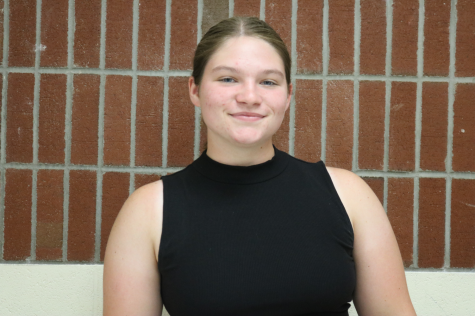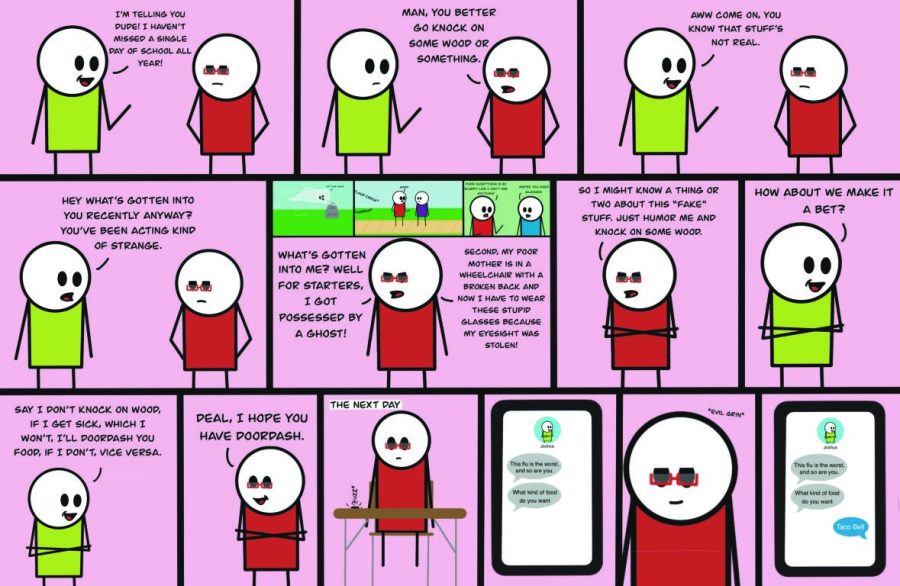Time out: Navigating the complexities of parental leave
Katelin Sondles wraps up a few loose ends at her desk on a Friday afternoon before she can go home to her two-year old daughter. Photo Credit: Andrea Nichols
Sitting at her desk, English teacher Katelin Sondles is surrounded by photos. Shelves line the walls filled with picture frames, and photo collages full of smiling faces. There is a small swaddled baby lying in a hospital bassinet in one photo and the same baby smiles in adorable outfits with large flowery headbands and is held lovingly by friends and family in others. This little girl is none other than Sondles’s own daughter.
“I had been hopeful to become a mom for quite a long time before I actually became pregnant,” Sondles said. “So, I was very excited to finally have the opportunity to have a baby.”
Sondles went on Maternity leave starting in February 2021 to prepare for the birth and care of her daughter, who came on Feb. 20, 2021.
“It perfectly worked out to where my 12 week leave took me right to the very last week of the school year. So, not only did I get my 12 weeks off of typical maternity leave, but it brought me into summer,” Sondles said. “I ended up being really lucky that I got almost six months with my daughter before she went to daycare and I came back to teaching.”
However, out of the 12 weeks of leave that Sondles used during her maternity leave, only six weeks were paid.
“Right now, mothers at the day of birth get six weeks where they can use their sick days,” Kings Education Association President (KEA) Sam Mizener explained. “Now that’s important. You don’t just get six weeks. Our leave is split up into sick leave, which we get 15 days every year, and three personal days. So, assuming that a teacher has accumulated enough sick days, they’re allowed to use six weeks of that sick leave for maternity leave, starting the day the baby was born. If it was a C-section, there’s more recovery time for that. So, they’re allowed to use eight weeks of their sick leave that’s accumulated.”
Essentially, teachers can get up to six weeks of paid maternity leave (eight for births via C-sections), but they must accumulate sick days to get it. Assuming six weeks of paid leave consisting of five work days each, for a total of 30 days leave, teachers must accumulate at least two years worth of sick days to get the maximum amount of paid parental leave.
Any other parental leave that teachers take is covered under the Family and Medical Leave Act (FMLA). This includes any days of leave during the initial six weeks not covered by amassed sick days, and the additional six weeks of leave teachers can take after their paid time off.
The FMLA allows for 12 weeks of unpaid leave for Americans, but not without stipulations. In order to qualify for the FMLA, Americans must meet a variety of criteria. To start, the company they work for must be covered by FMLA, and their work location must have 50 employees, which can eliminate many small and local businesses from coverage. Additionally, employees must have worked for their employer for at least 12 months prior to taking their leave, and have worked at least 1,250 hours within the last year.
This means that teachers who don’t have enough sick days are left with no choice but to take unpaid leave.
“We don’t get paid as much from being on maternity leave. They basically take your salary, chop out the time that you’re gone, and then pay you,” Social Studies teacher Joy McGee said. “So, I still get a paycheck every two weeks, but it’s significantly lower because I didn’t have the sick time saved up.”
This loss of income also comes at a time when new parents are facing the expenses that come along with children.
“Paying for daycare is exhausting. I mean, it is $345 a week. No matter what,” McGee said. “That’s been really challenging. Trying to financially make sure that my family is taken care of, and then also having the energy to come in here every day and be the best person, teacher, I can be.”
Juggling parental leave with fluctuating income and expenses is not only a problem for teachers locally, but also nationally. Currently, only 11 states and Washington D.C. have laws that provide for paid family and medical leave for people employed in the state, and there are no laws nationally. The FMLA is the only national law that provides for parental leave, unpaid parental leave.
This policy for leave is much less than the rest of the world offers its citizens. According to the Organization for Economic Co-operation and Development (OECD), the United States is the only one of 38 OECD member countries that offer no form of paid maternity leave. The OECD is an organization that allows governments to compare economic policy and growth in order to find answers to problems, identify good practices economically, and develop strong economic policies. In fact, globally, the U.S. is one of only eight countries that offer no paid maternity leave.
Teachers can also face further difficulties getting paid leave compared to private sector workers.
“I think the public sector, which includes schools, are behind the private sector. I have friends who work for [General Electric] and there’s a lot more flexibility with paternity leave and stuff,” Mizener said. “So, the United States is behind the rest of the countries, but then also, I think the public sector is behind too.”
A financial solution for teachers would be to go back to work earlier to avoid unpaid time off, but the problem with this is that maternity leave is an important time for recovery, bonding, and schedule development.
“Being near the baby helps with a lot of symptoms that women experience in terms of postpartum blues or postpartum depression,” University of Cincinnati College of Medicine Associate Professor-Educator Dr. Heather Chrisensen said. “Having a near bond with the child helps.”
Additionally, there are stress levels and physical changes that happen during the time that maternity leave takes place that can have an effect both on the child and the mother.
“I don’t know what the recent literature shows, but there are studies that talk about parents who go back to work early, after four or six weeks, who experience high levels of stress that can interfere with things like lactation, breastfeeding. It also has other mental health detriments from going back to work too early.”
Christensen said that assuming that the delivery went well, and that mother and child are healthy, the ideal minimum time off is the total of what is covered by the FMLA.
“Ideally, 12 weeks is the minimum that I would offer,” Christensen said. “Six months is incredibly beneficial.”
Christensen also discussed the events happening during those first few months that can be important to give families time to work out. During the first couple of months, important infant milestones occur, such as developing a sleep schedule, eating schedule, facial recognition and breastfeeding. Thus, it makes sense for parents to be home during this time to ensure these milestones are progressing properly during this time.
“You go [to medical checkups] probably half a dozen times in the first three months of their life. Logistically wrapping your head around all the checkups that are happening kind of indicates how much development is going on,” Christensen said.
While no protections for paid leave during this critical time exist on the federal level, they are starting to appear at the state level and among individual employers.
For teachers specifically, education associations have worked to rewrite expiring contracts with concessions that provide for paid maternity and parental leave. The Columbus Education Association (CEA) gained the concessions for up to 6 weeks of paid leave for full-time teachers following a strike in August 2022 at the beginning of the 2022-23 school year. Eventually, the CEA was able to come to an agreement with the Columbus City School Board over a new three year contract.
For teachers, support from administrators, colleagues and the district as a whole makes it much easier to take the time they need as parents, without stress.
“I feel like our district is really accommodating to the women in it,” Sondles said. “To allow us to take the time that we want to take.”
Want to show your appreciation?
Consider donating to The Knight Times!
Your proceeds will go directly towards our newsroom so we can continue bringing you timely, truthful, and professional journalism.

Emily is a senior this year and is a staff writer for the news section of the Knight Times. Her favorite part of working for the Knight times is getting...








































